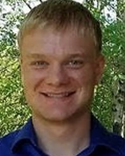2020 Slatt Scholars

Akin Adegoke
Winter 2020-21 Project: Integrating Photovoltaic Infrastructure and Agriculture
Department of Aerospace and Mechanical Engineering
Faculty Advisor: Paul Rumbach
The use of renewable energy has accelerated the effects of climate change. Countries have developed programs to expedite the creation and implementation of renewable energy into the grid system. However, in an ironic attempt to save the world, many corporations often ignore the impact on the natural ecosystem. The construction of solar farms can be a source of renewable energy, however the location is essential to the positive environmental effect it could have. For example, during the construction of the Ivanpah solar farm in the Mojave desert, the number of desert tortoises that would be displaced were greatly underestimated. The same solar farm also came under scrutiny when there was a sharp increase in bird death directly correlated to the construction of the solar farm. The purpose of this research is to develop a way to effectively integrate solar cells and farms so that we can effectively mine solar energy with little to no damage to the natural environment.
The idea is to install semi-transparent solar panels at a suitable height above a crop, giving space for plants to grow underneath, while also using a plant-microbial fuel cell to harness electron waste-products of photosynthesis to generate electricity. The objective of this research is to simultaneously address global demand for food and sustainable energy, and integrate the natural environments with energy-collection systems to minimize land usage, making these two sectors complementary rather than competitive.

Annika Barron
Winter 2020-21 Project: Radiolysis of Lunar Regolith and Surrogates
Department of Physics
Faculty Advisor: Jay LaVerne
Earlier this year, NASA’s Stratospheric Observatory for Infrared Astronomy discovered water on the sunlit surface of the moon. While it was only a tiny amount, this discovery raises very important questions about where this water came from, whether it will last, and the implications for the future of space exploration. One theory is that the proton bombardment of metal oxides creates both surface hydroxides and water. This research seeks to understand the effects of radiation chemistry on lunar regolith, the fine powder on the surface of the moon, and whether this radiation process could have led to the formation of water on the moon’s surface.
In order to answer these questions, we will begin by examining iron oxides and silicon oxide nanoparticles (which act as surrogates for lunar regolith) to develop protocols and an effective process, and then we will examine real lunar soil. Radiolysis will be performed using accelerated protons from the 9S accelerator in the Nuclear Science Laboratory, as well as gamma rays from other resources in the Radiation Laboratory. Before and after radiolysis, spectroscopic techniques, including UV-visible, infrared, Raman spectroscopy, and x-ray scattering will be used to examine the materials and determine the ways in which the elemental composition and properties may have changed. Using this analysis, we hope to understand the effects of radiation on lunar soil, hopefully leading to a conclusion about the formation of water on the moon’s surface.

Austin Booth
Annual 2020 Project: Development of an Operando Spectroscopic Tool for Studying the Structure and Dynamics of Membranes in Complex Environments
Department of Chemical and Biomolecular Engineering
Faculty Advisor: Casey O'Brien
Society depends on chemical separations for many basic necessities, including clean water, chemical products, medicines, fuels, and food. However, most industrial chemical separations are performed using thermal techniques, such as distillation, which consume an enormous amount of energy: about 10-15% of the world’s total energy consumption. Advanced membrane technologies that can efficiently separate chemicals have the potential to reduce the energy intensity of chemical separations by ~90%, which would have a substantial global impact. However, development of high-performance membranes is hindered by limited understanding of the fundamental molecular-scale processes that determine membrane performance, especially in complex environments. In this research project, the O’Brien group aims to address this knowledge gap by developing and testing a new operando spectroscopic tool that will probe the chemical structure and dynamics of membranes in complex environments. While operando spectroscopy is a well-established approach in catalysis, it has not been widely adopted by other fields, including membrane science. PI O’Brien is the first to apply operando spectroscopy to gas separation membranes, and his group has already developed a successful operando spectroscopy tool that simultaneously measures hydrogen permeation rates and surface-adsorbed species across dense metal membranes. This project’s goal is to develop a similarly effective but more versatile tool that can be used to study a diverse range of membrane separation systems (polymer, ceramic, metal; gas or liquid mixtures) using various types of spectroscopy, potentially greatly impacting the entire membrane science field. The overarching goals of the research project are to develop a new operando spectroscopic tool and demonstrate that this tool can provide unique information about the structure and dynamics of membranes under realistic and complex operation conditions. To achieve this goal, a new spectroscopic permeation cell will be built, and the tool will be constructed by combining the permeation cell with a Raman spectrometer, mass flow controllers, and a gas chromatograph in order to monitor the chemical structure of the membrane and solute permeation rates simultaneously. The tool will be used to monitor the chemical reactions occurring in polyvinylamine (PVam) facilitated transport membranes under simulated industrial conditions during the transport of carbon dioxide across the membrane. The mechanism occurring in these membranes is not well-understood, so a specific goal of the project in this application is to use the new tool to identify the intermediate species in the PVam-CO2 reaction and thus clarify the mechanism of CO2 transport. As a result, both the behavior of these commonly used membranes will be elucidated and the spectroscopy tool’s ability to analyze such membranes will be proven.

Andrew Chen
Annual 2020 Project: Determining the effect of microfibers for drag reduction in pipe flow
Department of Aerospace and Mechanical Engineering
Faculty Advisor: Hirotaka Sakaue
Skin friction causes drag when objects are in motion in a fluid, and to overcome this drag, more energy has to be expended on moving large ships or moving fluids through pipelines. The motivation for this project is to increase the efficiency of existing pipe systems by applying microfibers in a pipe to reduce drag. In this research, microfibers will be fabricated and applied to the inner surface and experimented on in our water tunnel. Ultimately, the objective of this project is to determine a suitable arrangement of microfibers that satisfies the company we work with.

Thomas Coates
Department of Computer Science and Engineering
Faculty Advisor: Sergey Leonov
Fall 2020 Project: Nanosecond resolution camera imaging of a single-pin streamer electric discharge
This undergraduate student project is a part of extensive work performed in collaboration with Princeton University. The entire experimental research focuses on the dynamics of volumetric charge and energy dissipation in the case of a single pin electrode streamer corona electric discharge generated in an open atmosphere (P = 1 bar) with alternating polarity high-voltage waveform. Recent studies show that surface electric charge deposited by the high-voltage pulse discharge greatly affects the discharge parameters and morphology. In addition, a similar behavior was found out for a volumetric single-pin discharge. This type of discharge produces waves of volumetric electric charge concomitant with a redistribution of electric field that significantly influences the discharge pattern. An understanding of the effects of space charge on the discharge characteristics is one of the most important for the study of low-temperature plasmas; however, it has been largely underexplored due to the unavailability of a proper measurement tool. The particular portion of this work includes the visualization of the discharge morphology with a nanosecond resolution. The work will consist of the discharge triggering with a low jitter technique, use of ISSD camera for a detailed visualization, and mapping of the discharge pattern vs the phase of propagation.
Winter 2020-21 Project: Probe waveform and nanosecond imaging comparative analysis for volumetric space charge waves
A streamer corona electrical discharge is commonly realized in many practical devices and technologies dealing with a high-voltage electricity. In some cases, such a discharge is intentionally generated, e.g. for surfaces/materials processing, plasma medicine, electronic devices, and others. In many other cases, the corona discharge appears as a parasitic phenomenon, leading to malfunctions and failures. Knowledge of the streamer corona discharge pattern and dynamics is urgently required for development of proper control procedures. Recent studies show that surface electric charge deposited by the high-voltage pulse discharge greatly affects the discharge parameters and morphology. In addition, a similar behavior was found for a volumetric single-pin discharge. This type of discharge produces volumetric electric charge waves concomitant with a redistribution of electric field that significantly influences the discharge pattern.
In general, an understanding of the effects of space charge on the discharge characteristics is one of the most important for the study of low-temperature plasmas. However, it has been largely under-explored due to the unavailability of a proper measurement tool. The particular portion of this work includes the visualization of the discharge morphology with a nanosecond resolution by means of an advanced ISSD ANDOR iStar camera. The major objective of this work is to correspond the acquired images to the electric field morphology and the pulse high-voltage generator waveform. The targeting of this goal is completely within the scope of the ND Energy activity.
Research tasks will consist of experimental efforts, numerical simulations and the data analysis, including:
- imaging of the streamer corona discharge with a high temporal resolution, down to 10 nanoseconds
- numerical simulation of the electric field morphology in a complex geometric configuration
- adjustment of the experimental set-up parameters to diminish secondary effects
- parametric analysis of data, including the waveforms of plasma initiation, high-resolution images, and initial electric field configuration

Hannah Collins
Fall 2020 Project: Fundamental materials studies on fast ion diffusion in model side-chain ionomers
Chemistry and Biochemistry
Faculty Advisor: Jennifer Schaefer
It is now possible to generate renewably sourced electricity at similar, and even sometimes lower, cost to fossil fuel sourced electricity. However, in order to fully take advantage of this renewably sourced electricity, it needs to be stored for grid load leveling and for use in transportation. Advanced electrolytes are sought to enable the commercialization of energy storage devices with improved performance metrics: higher safety, higher energy density and power, higher voltage, longer lifetime, lower cost. This project is focused on understanding ion transport mechanisms in new electrolytes to enable the desired advances in battery performance.

Robert Crawford
Winter 2020-21 Project: Solar Energy Potential in South Bend
School of Architecture
Faculty Advisor: John Onyango
Among the various ways in which cities and groups across the country are attempting to mitigate climate change, the American Institute of Architects is promoting the “2030 Challenge,” which seeks to make all new buildings and renovations carbon-neutral by the year 2030. One efficient way to achieve this goal involves retrofitting existing housing with non-polluting solar generation devices. This research examines the potential energy savings from retrofitting solar panels to the roofs of buildings in South Bend, specifically those buildings in the block defined by E Angela Blvd, Napoleon St, and Duey St. Using GIS maps to generate roof geometries and information from the latest available solar panels on the market would provide an estimate of the energy production that can be added to South Bend’s grid. The data gathered from this research could have larger implications for the city of South Bend, as the long-term energy savings could encourage the implementation of solar panels across the city.

Neila Gross
Winter 2020-21 Project: Understanding the Effects of Sonication on Biofilm Removal
Department of Chemical and Biomolecular Engineering
Faculty Advisors: Albert Cerrone / Robert Nerenberg
Biofilms are the most common form of microbial growth, and a major problem in many engineered systems. For example, biofilms can foul water filtration systems, increasing energy demands. They also can coat pipelines and ship hulls, increasing the hydraulic drag. Most biofilm removal approaches are ineffective, expensive, or not “green.” New, more effective biofilm management approaches could greatly decrease power demands. The proposed research investigates sonication as a “green” approach to removing biofilms. Sonication can be applied non-invasively, requires little energy, and does not require harmful chemicals. Sonication has been shown to kill cells in some studies, and to weaken the biofilm matrix of extracellular polymers (EPS) in others, leading to detachment. The lack of a basic understanding of the mechanisms of sonication on biofilm removal hinders its effective use. In this research, the effects of different types of sonication will be systematically investigated. In particular, the effects of sonication on cell viability and viscoelastic behavior of biofilms will be studied.
Several biofilm cultures of the same species (e.g. Pseudomonas aeruginosa) will be subjected to different frequencies, power, and duration of ultrasound. These cultures will then be tested mechanically and for cell viability. Specifically, shear rheometry in the ND Energy Materials Characterization Facility (MCF) will be used to measure the biofilm viscosity and shear modulus before and after sonication. The MCF’s atomic force microscope may also be used to quantify stress-strain response. Additionally, EPS staining chemicals will be used to visualize key EPS constituents (e.g., proteins, lipids, polysaccharides, and DNA) and potentially identify / quantify their degradation. Mechanical properties will then be correlated to the regimen of sonication (viz. frequency, power, time). The results of this study could lead to new, more effective strategies to manage biofilm fouling.

Samuel Gruenler
Fall 2020 Project: Risk Assessment in Energy Markets
Department of Economics
Faculty Advisor: Christiane Baumeister
The purpose of this project is to analyze market participants' beliefs about future movements in oil prices around important market events using option prices. Specifically, we want to assess how the risk assessment of oil companies and investors changes in response to episodes of high geopolitical tensions, oil supply disruptions, shifts in OPEC production strategies, as well as macroeconomic developments. For example, the recent Saudi-Russia oil price war and the economic crisis related to the pandemic are important events that shift people's perception of risk of the future course of oil prices. This has important implications for their behavior and the future demand for oil. We will study the probability that market participants assign to unlikely events by using options-implied probability density functions. Sam's main tasks would be to collect and clean high-frequency option price data, analyze the data by writing code to obtain option-implied probability density functions and select specific market events to examine changes in risk assessment.

Alexander Hymes
Fall 2020 Project: Introducing exchangeable dynamic cross-links into polymer networks
Department of Chemistry and Biochemistry
Faculty Advisor: Haifeng Gao
Polymeric materials have infiltrated into every corner of our life from household items to industrial materials. Among these various applications, polymer thermosets with permanent crosslinks are often the choice of materials because of their dimensional stability, mechanical properties and creep/chemical resistance. However, these thermosets cannot be reshaped, processed or recycled. Considering the explosive growth of plastics waste resulting from difficulties in addressing end-of-life usage, there is a pressing need for a new generation of thermosets materials that can be reprocessed, like thermoplastics, yet still retain the beneficial properties of a crosslinked thermoset material. Recently, an attractive chemical strategy by introducing exchangeable dynamic cross-links into polymer networks is proposed. If chemical cross-links can be efficiently and reliably exchanged between different positions of the polymer chains, macroscopic flow can be achieved without risking structural damage or permanent loss of material properties. These polymer networks containing such exchangeable bonds are called as covalent adaptable networks or CANs. In this project, Alexander Hymes will be designing a type of CAN materials based on our recently developed Friedel-Crafts (F-C) hydroxyalkylation polymerization technique. Alex will be responsible for studying the imines exchange reaction in our F-C polymers to construct the CAN materials. By investigating the imine bond exchange kinetics under various conditions, Alex aims to identify the optimal materials composition and structure to produce CAN materials with the best mechanical properties and re-processibility.

Brendan Kane
Fall 2020 Project: Developing Luminescent Ice
Department of Aerospace and Mechanical Engineering
Faculty Advisor: Hirotaka Sakaue
Brendan is going to work on a new energy-related topic using a luminescent probe. The Sakaue lab is developing a "luminescent ice" that can be used to quantify the melting of Antarctic ice beds under solar radiation. It is challenging to identify a good luminescent probe that can be used for ice, and we need an undergraduate student who can help us to do trial and error type of tests. If successful, this luminescent ice can be used for various energy topics that are related to ice.

Brian Kang
Winter 2020-21 Project: How Chloride Suppresses Photoinduced Phase Segregation in Mixed Halide Perovskites
Department of Chemical and Biomolecular Engineering
Faculty Advisor: Prashant Kamat
In general, this research is focused on excited state properties of different types of perovskite materials. For this specific research project, chloride is used to stabilize the perovskite solar cells, and has a strong influence on halide ion mobility. Halide ion mobility is directed by the viscosity of the solvent and affects the overall performance of the perovskite solar cell, especially in terms of its stability. The research project aims to see how varying the concentration of chloride (in a range from 1-10%) will affect rate and amount of halide segregation from the mixed phase. The project also analyzes the change in activation energy depending on the amount of chloride introduced, investigating the excited state after the change of chloride concentration.

Thomas Kasl
Winter 2020-21 Project: 3D-Printing Hierarchical Nanostructure Absorbance for Contaminant Removal and Resource Recovery
Department of Chemical and Biomolecular Engineering
Faculty Advisor: William Phillip
Effective and sustained effort in the Phillip Group has proven that a custom-3D-printing system can create well-defined polymer membranes with finely-tuned hierarchical structures. We plan to construct membranes made from a tri-co-polymer solvent system with integral carbon nano-tubes. Additionally, Non-Newtonian flow allows for desirable printing properties. 3D-printing these types of membranes will allow us to have high porosity and therefore high energy efficiency-contaminant removal and resource recovery. Applications include: nitrate recovery from fertilizer runoff; lead removal from contaminated water in areas such as Flint, MI; and heavy-metal ion recovery from industrial chemical processes.

Collin Kemper
Winter 2020-21 Project: Optimization of Fog Harps as an Energy-Free Method to Collect Drinking Water for Caribbean Nations
Department of Chemical and Biomolecular Engineering
Faculty Advisor: Kyle Doudrick
Lack of drinkable water is a very serious issue facing countless people around the world. In some island nations, such as the Caribbean, lack of infrastructure severely inhibits access to drinking water. In these nations, ocean water cannot easily be used due to the massive costs and energy requirements of modern desalination techniques (e.g. reverse osmosis). There is, however, an untapped source of fresh water that occurs most days of the year in island nations: fog. When water is gathered from the air, energy must normally be used to condense it (e.g., dehumidifier), but fog is composed of water aerosols that have already condensed from the air. Fog can be captured by passing it across a surface, allowing for sustainable collection of fresh water that can be used for household tasks and potentially drinking. The key challenge is designing a simple and affordable device with a high surface area and proper thermal conductivity that allows fog to accumulate.

Emma Kerr
Fall 2020 Project: Fundamental materials studies on fast ion diffusion in model side-chain ionomers
Department of Chemical and Biomolecular Engineering
Faculty Advisor: Jennifer Schaefer
It is now possible to generate renewably sourced electricity at similar, and even sometimes lower, cost to fossil fuel sourced electricity. However, in order to fully take advantage of this renewably sourced electricity, it needs to be stored for grid load leveling and for use in transportation. Advanced electrolytes are sought to enable the commercialization of energy storage devices with improved performance metrics: higher safety, higher energy density and power, higher voltage, longer lifetime, lower cost. This project is focused on understanding ion transport mechanisms in new electrolytes to enable the desired advances in battery performance.

Cara Kilmartin
Winter 2020-21 Project: Resource Recovery using Diafiltration Membrane Modeling and Separation Processes
Department of Chemical and Biomolecular Engineering
Faculty Advisor: William Phillip
The global water demand continues to stress supplies of freshwater, evoking a need to explore processes of producing usable water from nontraditional sources. Energy and water are intricately related, as reducing the energetic input of water purification processes is an essential component in developing sustainable methods to alleviate the global water burden. Membrane separations generally produce high purity water with less waste and relatively low energy demands. Desalination processes use reverse osmosis membranes to permeate water and reject all solutes, which generates potable water. However, reverse osmosis requires a large amount of energy to overcome the substantial osmotic pressure in separating a pure stream of water from a high salinity source. The energy intensity of reverse osmosis is a significant drawback to the technology, which has led to the exploration of hybrid processes that use less saline water sources, such as municipal and industrial wastewater. Hybrid membrane processes are generally less energy-intensive and have the potential for resource recovery while still producing a sufficient quality of water. Resource recovery is the process of using a waste source to extract something of value (e.g. nitrate and phosphorous can be recovered from human excreta). Nanofiltration is a pressure-driven membrane process that complements reverse osmosis. With pore sizes ranging from 2 – 8 nm in diameter, nanofiltration membranes exhibit selective rejection mechanisms rather than rejecting all solute indiscriminately. At this pore size, electrostatic interactions and van der Waal effects are principal for the membrane selectivity. For instance, the electrostatic repulsions between divalent cations and nanofiltration membranes result in these molecules being rejected at higher rates. However, smaller, monovalent salts can more easily permeate the membrane along with water, which helps to reduce the osmotic pressure and energy required. A parameter known as the sieving coefficient, which is calculated as the ratio of the solute concentration in the permeate solution to the solute concentration in the feed solution, describes the membrane selectivity for a given solute. The sieving coefficient is a function of the membrane pore size and solute sizes.
Electrostatic interactions between particles in nanofiltration can help mediate transport rates, which has important implications for resource recovery. By tailoring the electrostatic interactions and pore size, the nanofiltration process could target distinct solutes for recovery. The nanofiltration process alone becomes problematic, as typically more solvent is pushed across the membrane than solute, leading to drying out of solute. Diafiltration introduces an intermediary inflow of solvent to increase the amount of solute permeated across the membrane, making this process suitable for resource recovery. Targeting the recovery of resources (i.e. nitrate, phosphorus, and lithium) that exist in wastewater would increase sustainability and create a profit, which would reduce the cost associated with water reuse. The selectivity and permeability of diafiltration systems can be quantified through the use of a mathematical model. I derived the initial framework of the diafiltration model using a series of mass balances to predict the results of theoretical data. In order to predict the experimental results, I will adapt the model to fit the physical constraints of the diafiltration experiments conducted in the WATER lab. This improvement will allow for direct comparisons between predicted values and analytical data to ensure the model's accuracy. Two different nanofiltration membranes, which vary in sieving coefficients, will be analyzed for the solutes of interest and compared to the model's results to validate the model. Once validated, the model can be used to contemplate the trade-off between solute recovery and solute purity through an optimization process. The results of this optimization would directly inform future experiments with the hope of recovering an abundance of high purity resources while conserving resources, energy, and time.
Cara Kilmartin Final Report
2021 Journal Publication (first author)

Olivia Lanchoney
Winter 2020-21 Project: Synthesis of a Three-Coordinate Nickel Alkylidene
Department of Chemistry and Biochemistry
Faculty Advisor: Vlad Iluc
A tremendous amount of research has been dedicated to the investigation of transition metal carbenes for their utility in carbon-carbon bond formation. Understanding the properties of transition metal carbenes may open new doors to the synthesis of specific organic products, such as pharmaceutical and natural compounds. Specifically, nickel carbenes are a focus of interest due to their economic advantages, non-toxic characteristics, and the rich catalytic activity of the group 10 transition metals. In this project, I aim to synthesize a three-coordinate nickel alkylidene, which has never before been synthesized. Thus far, three-coordinate nickel-carbene complexes have been synthesized but all of these examples contain either one or two aromatic substituents. [1, 2] Unlike these compounds, a nickel alkylidene would lack these electron-rich substituents, and its synthesis may provide new insight into the bonding and reactivity of nickel-carbene complexes.
[1] Daniel J. Mindiola, Gregory L. Hillhouse. Synthesis, Structure, and Reactions of a Three-Coordinate Nickel-Carbene Complex, {1,2-Bis(di-tert-butylphosphino)ethane}NiCPh2. Journal of the American Chemical Society 2002 124 (34), 9976-9977. DOI: 10.1021/ja0269183
[2] Vlad M. Iluc, Gregory L. Hillhouse. Three-Coordinate Nickel Carbene Complexes and Their One-Electron Oxidation Products. Journal of the American Chemical Society 2014 136 (17), 6479-6488. DOI: 10.1021/ja501900j

Seryeong Lee
Fall 2020 Project: Understanding the coordination geometry of individual surface sites in nanomaterials
Department of Chemistry and Biochemistry
Faculty Advisor: Emily Tsui
This project models the FTIR spectra of organometallic fragments coordinated to the surfaces of semiconductor nanocrystals. The goal of this project is to understand the coordination geometry of individual surface sites in nanomaterials, as surface chemistry can dominate the optoelectronic properties of these materials in energy applications such as photocatalysis or in photovoltaics. In addition to the modeling work, Seryeong will be working in the lab to synthesize different nanomaterials and will synthesize new organometallic compounds to attach to their surfaces. These functionalized materials will be characterized spectroscopically.

Erin Ludwig
Winter 2020-21 Project: Using Chemical Lichenometry to Understand Coastal Storm Deposits
Department of Civil & Environmental Engineering & Earth Sciences
Faculty Advisor: Melissa Berke
The objective of this research will be to physically and chemically characterize coastal boulders and lichens growing on them from samples gathered in western Ireland. This data will be used to assess the likelihood of using these growths for compound-specific radiocarbon dating (chemical lichenometry) to determine how long these boulders have been at the coastline. Large boulders on coastal rock platforms, such as those in western Ireland, are covered in similar lichen growths and were moved by waves from storm events. However, the size and frequency of the storms that move these boulders, and how long they have been resting there, is still unknown. Studying these boulders and determining the power of the storm necessary to move them will help us learn about extreme coastal events. Understanding coastal storm frequency and power is critical for developing resilient coastal energy infrastructure, such as wind turbines and power plants, already under threat from sea level rise.

Andrew Scott Manning
Annual 2020 Project: Using Molecular Simulations to Characterize Phase Behavior of Liquid Electrolyte Systems
Department of Chemical and Biomolecular Engineering
Faculty Advisors: Jonathan Whitmer and Jennifer Schaefer
In this project, I plan to study the theory and applications of molecular simulations using the GROMACS software package. Molecular simulations can be used to gain insight into the structure of the liquid electrolyte in a battery, and the structure of the electrolyte determines the ion transport properties of the battery. From this work, I hope to develop a solid foundation for using molecular simulations with complex systems, which will prepare me to begin simulating the liquid crystal electrolyte system. This research will contribute to advancements in sustainable energy storage solutions and the implementation of widespread intermittent renewable electricity generation technologies such as photovoltaics and wind power.
Andrew Scott Manning Final Report

Audrey Miles
Winter 2020-21 Project: Benchmarking Ammonia Synthesis Entropies in Microkinetic Modeling
Department of Chemical and Biomolecular Engineering
Faculty Advisor: William Schneider
Most significant chemical processes are catalytic in nature, including those relating to emission control, sustainable energy, pollutant removal, and the fabrication of technologies. This widespread use of catalysis has motivated research efforts to streamline industrial processes through the optimization of catalytic performance. By studying the rates and equilibrium constants for elementary reaction steps, the overall catalytic efficiency of a given process can be evaluated and improved. Microkinetic modeling has emerged as one such tool to compute these rate constants and equilibrium constants, leading to a heightened understanding of governing reaction mechanisms. A critical component of these microkinetic models is an accurate approximation of the enthalpies and entropies of the species under consideration. Without appropriate approximations of the entropic changes in the system, kinetic models are rendered inaccurate. Popular approaches to compute these entropies and free energies include the lattice gas model or the ideal gas model. The lattice gas (harmonic oscillator) and ideal gas models assume that an adsorbate’s translational degrees of freedom are either constrained or relaxed on a surface respectively. However, these models are not robust, with their individual weaknesses being exposed by various situations. The Schneider group has developed a more sophisticated model that has been shown to accurately bridge the gap between the lattice gas and ideal gas models. This model, known as the complete potential energy sampling technique, utilizes the exact energy landscape rather than assuming some functional form of the potential energy surface.
One such significant catalytic system involves the sustainable production of ammonia. Large-scale ammonia production is one of the most important synthetic chemical processes globally, with production plants generating over 150 million tonnes of ammonia per year. Beyond its main use in fertilizers and the agricultural industry, ammonia is also used in water purification, plastics, fibers, pharmaceuticals, dyes, and pesticides. The typical process used in ammonia production involves the removal of sulfur compounds from natural gas feedstock, several catalytic conversions to facilitate the removal of carbon dioxide and carbon monoxide to generate hydrogen gas, and the reaction of nitrogen gas with the hydrogen gas to form liquid ammonia. This cycle, though, requires high pressures and temperatures, and there are relatively low single-pass conversion rates. In addition to this, the process requires an abundance of energy and natural gas. Ammonia synthesis is therefore vital to global industries, but inefficient in its use of energy and valued natural resources. For this reason, a more sustainable approach to the production of ammonia is desired. Microkinetic modeling, as discussed previously, is one method through which ammonia synthesis may be better understood and ultimately optimized. As such, accurate models to describe the translational, rotational, and vibrational degrees of freedom are needed. This project will aim to evaluate the ability of various models to accurately calculate the entropic contributions of ammonia synthesis and develop microkinetic models describing the overall catalytic process.

Stephanie Mueller
Winter 2020-21 Project: Zinc(II) Carbene Synthesis and Reactivity
Department of Chemistry and Biochemistry
Faculty Advisor: Vlad Iluc
The Iluc group has synthesized the (bis[2-(di-iso-propylphosphino)phenyl]methylene (PCP) ligand and used it to make Fe, Pd, and Pt carbene complexes. These molecules proved to be useful in activating different substrates. My goal is to synthesize a Zn(II) carbene with this PCP ligand. If this is successful, then I will determine the carbene’s structure and reactivity, focusing on carbene insertion into C-H bonds. Kulkarni, Naveen V., et al. found that Zn(II) can do this in alkanes.
Zn(II) is a cheap and earth-abundant metal that also has unique chemical properties. Zn(II)’s reactivity comes from the fact that that Zn has completely filled 3d orbitals, which gives it only one attainable oxidation state. Zn2+ is a redox-stable ion that can function as a Lewis acid–type catalyst whereby it stabilizes negative charge and activates substrates (Butler 1998). Zn(II) complexes also have ligand-field stabilization energies of zero (Huheey et al. 1993) in all geometries, allowing Zn(II) complexes to access multiple coordination geometries within a catalytic cycle. This would be especially useful to catalyze chemical transformations accompanied by changes in the metal coordination geometry.
It is apparent that a Zn(II) catalyst would be useful because the human body uses Zn(II) in all six classes of enzymes (Maret W 2013). Creating this novel molecule could allow biochemists to perform biological reactions in vitro, or it could allow organic chemists to synthesize important organic molecules with a more energy efficient catalyst.
Stephanie Mueller Final Report

Marlena Muszynska
Winter 2020-21 Project: Synthesis, Characterization and Electrochemical Testing of Iron/Iron Oxide Clusters as Potential Replacements for Platinum in Hydrogen Fuel Cells
Department of Biological Sciences
Faculty Advisor: Ian Lightcap
This research project will build on the successful efforts of previous undergraduate students who were able to synthesize sub-nanometer Fe clusters on graphene sheets. In this project we will make sure the synthetic process can be repeated, then characterize the resulting graphene-iron cluster composites in order to understand the nature of the iron (size distribution, chemical environment and stability) as well as how those properties affect its suitability towards the oxygen reduction reaction (ORR), and thus as a potential replacement material for platinum in hydrogen fuel cells.
Marlena Muszynska Final Report

Jacob Novitch
Fall 2020 Project: Effect of hydroxylamine on the structure and function of nitrifying biofilms
Department of Civil & Environmental Engineering & Earth Sciences
Faculty Advisor: Rob Nerenberg
This project studies a novel, biofilm-based treatment technology for wastewater treatment. Wastewater treatment is a major energy sink, accounting for 2 - 4% of electrical energy consumption in the US. Our proposed treatment could greatly reduce these energy demands, or even make wastewater treatment energy positive. We propose a new biofilm process combining gas-permeable membranes with water- permeable membranes. The gas-permeable membranes supply O2 with nearly 100% efficiency. The water-permeable membranes supply a chemical to alter the microbial community of the biofilm growing on the membrane assembly. Specifically, we propose supplying hydroxylamine, which we hypothesize can alter the biofilm community in ways that reduce the O2 requirements and allow more wastewater organic matter to be directed to the anaerobic digesters. These anaerobic digesters produce methane, an energy carrier that can be used to fuel cars, produce electricity, or provide heat.

Daniel Palmer
Annual 2020 Project: Studying Conduction of Nematic Liquid Crystals
Department of Chemical and Biomolecular Engineering
Faculty Advisor: Jonathan Whitmer
A better understanding of the conduction of liquid crystals could help lead to new developments in photovoltaics, display technology, drug technology, and many other fields. This research uses computational techniques to measure electrical conduction of specific phases of liquid crystals.

Amanda Patterson
Winter 2020-21 Project: Breakdown of Uranyl Peroxide Nanoclusters in Low Aqueous Concentrations; Pueblo of Laguna
Department of Biological Sciences
Faculty Advisor: Peter Burns
This proposal includes two research projects. In the first project, I will study the breakdown of uranyl peroxide nanoclusters, specifically determining how changing pH and concentration affects the stability of the nanoclusters. These nanoclusters have been tentatively identified in nuclear waste, and their solubility in water makes them able to flow into water sources, such as a river or stream, contaminating the water supply with uranium. Compared to other elements on the periodic table, actinides have not undergone extensive study. Understanding the breakdown of uranyl peroxide nanoclusters will not only add to our understanding of an understudied group of elements, it will also help us learn the implications of the solubility of nanoclusters and how we can minimize spread of nuclear waste into the environment. In previous experiments, it was found that at low aqueous concentrations and acidic to circum-neutral pHs, the U60 nanocluster dissociates into studtite, a mineral. Since the clusters are initially synthesized by starting with studtite, this signifies that there is a reversible reaction between the nanoclusters and studtite. Speciation occurred at pH levels of 8, 10, and 11. By further probing the cluster under these conditions, specifically by varying the pH levels and concentrations, the formation mechanisms can be determined.
The second research project will involve rock samples from a uranium mine in the Pueblo of Laguna land, a tribe of Native American Pueblo people in New Mexico. Specifically, we will try to determine why the river across from the mine has high concentrations of total dissolved uranium. Uranium mining took place in the Pueblo from 1952-1982, and water samples from the Rio Paguate across from the mining operation show concentrations above 700 ppb of total dissolved uranium, when the maximum level deemed safe by the federal government is 30 ppb of uranium. By investigating and discovering why the concentration of uranium in the Rio Paguate is so high, we can then find a solution and lower the uranium concentration to a safe level. Rock samples were initially collected from the uranium mine, and quartz, uranyl minerals, and natural organic matter (NOM) was found on the samples. The organic material was extracted and put through a gas chromatography–mass spectrometer (GCMS), which showed what the identity of some of the organic matter is. Acetic acid was one organic detected, which at pHs above 5 will deprotonate and act as an anion increasing the solubility of the uranium minerals. The effects of precipitation on the level of uranium concentration in the river will be further explored with the rock samples. The breakdown of organic matter and its deprotonation from the surface of rocks via rainfall may be what causes the uranium concentrations in the river to be so high. Simulating rainfall and determining the organics that come off the rocks through this project will help confirm this, allowing greater insight into the source of uranium in the Rio Paguate.

Melanie Perez
Fall 2020 Project: Fabrication of Nanostructured Materials for Applications in Energy, Catalysis, and Sensing
Department of Aerospace and Mechanical Engineering
Faculty Advisor: Svetlana Neretina
The Neretina group is designing and fabricating nanostructured materials for applications in energy, catalysis, and sensing. Applications such as Concentrating Solar Power, Thermophotovoltaic, Sensing in Combustion Environments, and Photocatalysis require that nanomaterials withstand high temperatures and harsh chemical environments. The tendency for nanostructured materials to morphologically reconfigure when heated can, however, disrupt or destroy the properties that were so carefully engineered in the first place and, in doing so, puts important applications at risk. With the understanding that temperature-induced shape changes originate from the diffusion of atoms, the goal of this project is to synthesize noble metal nanostructures with an oxide skeleton where the skeleton’s purpose is to obstruct the most at-risk diffusion pathways so as to achieve a more stable configuration. Melanie will carry out various solution-based syntheses, characterize nanostructure properties, and test whether these properties can be maintained when the structures are exposed to heat treatments.

Kimberly Riordan
Annual 2020 Project: Synthesis and Electrochemical Studies of T-shaped Sulfur Radicals
Department of Chemistry and Biochemistry
Faculty Advisor: Emily Tsui
This year’s Nobel Prize in Chemistry was awarded to research discoveries on the lithium-ion battery. These batteries are lightweight and long-lasting, relying on the constant flow of lithium ions (1). The formation of soluble polysulfides is a degradation pathway for Li-S batteries, so therefore understanding its radical chemistry is important to longer battery lifetimes. Last year’s project targeted the synthesis and characterization of trigonal geometry sulfur radical. This approach was met with synthetic challenges, which are common. Consequently, this year’s project seeks to leverage an existing system to more readily access the relevant electrochemistry and spectroscopy. This research project focuses on synthesizing a different sulfur-based radical species. Imada, et al. have published a sulfur radical with T-shape geometry at the sulfur atom (2). By adding more electron-withdrawing groups, the radical should be more stable. These effects of changing substituents will be studied with the addition of sulfur in solution to measure the redox waves using cyclic voltammetry. This concept would have connections for the lithium-sulfur battery technology. We will also measure the isolated radical using electron paramagnetic resonance spectroscopy. Finally, we will study the solution-phase interactions with elemental sulfur as a method of stabilizing the soluble polysulfide species that are the reason why lithium-sulfur batteries degrade. In the synthesis of a T-shaped sulfur radical species, the starting compound will be 1-bromo-2,6-diorthoester. Treatment with C2F5Li and an excess of iodine is used to prepare an iodinane. The iodinane is trimetallated with n-BuLi and sulfur to yield the radical species. This route will be repeated with different substituents on the phenyl rings. We will consider groups with different electronics such as electron withdrawing and electron donating groups. Additionally, varying the positions and sterics of these substituents from the meta to the para positions will be studied. These compounds will be analyzed with electron paramagnetic resonance (EPR) spectroscopy. It can also be characterized by cyclic voltammetry and UV-vis spectroscopy.
(1) Press release: The Nobel Prize in Chemistry 2019. NobelPrize.org. Nobel Media AB 2019. Mon. 28 Oct 2019. (2) J. Am. Chem. Soc. 2016, 138, 479−482

Matthew Riss
Annual 2020 Project: Synthesis, Characterization, and Thermodynamic Properties of a Suite of Thorium Nitrate Salts
Department of Civil & Environmental Engineering & Earth Sciences
Faculty Advisor: Amy Hixon
As far as energy production goes, nuclear energy has and continues to be a hot topic. Past meltdowns and failures, such as the catastrophe in Fukushima, Japan in 2011 have caused public opinion to, in some cases, turn against nuclear energy. Despite this, nuclear energy continues to account for a significant amount of the world’s energy production, and likely will contribute to more of that energy production in the future as fossil fuels dwindle. In the past I have done research into different kinds of nuclear reactors, i.e. those not using uranium. I found that, although uranium reactors are predominant in nuclear energy, another, possible more sustainable option involves using thorium. Thorium salt reactors utilize molten salt to either cool or fuel the reactor, which brings along specific advantages. For example, not having to rely on water for cooling can be an advantage, as this factor (i.e. using water to cool) was a factor leading to the Fukushima meltdown in 2011. My research project would involve the characterization of different thorium nitrate salts. The main goal is to explore how different alkali cations affect the thermodynamics of thorium salt compounds. In this project, different thorium nitrate salts would be synthesized then characterized using a variety of techniques, including X-ray diffraction, thermogravimetric analysis, and calorimetry. Hopefully, the characterization of these salts would provide useful links or information that allows for conclusions to be made regarding the efficacy of these salts in the nuclear fuel cycle. Overall, exploring the thermodynamic properties of neglected thorium compounds will have significant consequences with respect to energy and nuclear energy specifically.

Robert Schaefer
Fall 2020 Project: Energy efficient parallel computing, with applications in large scale fluid simulations and machine learning
Department of Electrical Engineering
Faculty Advisor: Vijay Gupta
The Gupta group has been developing new algorithms for reducing time and energy consumption in parallel computing with interesting results that have caught the attention of funding agencies such as NSF, ARO, and DOE. Robert will be implementing some of the algorithms on GPU machines with the goal of demonstrating significant (30-50%) energy savings on GPU based codes.

Andrew Smith
Annual 2020 Project: Preparation and Analysis of Photoswitchable Ionic Liquids
Department of Chemistry and Biochemistry
Faculty Advisor: Brandon Ashfeld
Cooling systems are extensively employed in key industrial procedures for a variety of applications. However, these systems are reliant upon energy-inefficient materials. To limit the environmental impact of coolants, new polymers and liquids have been considered for absorption-cooling systems as a function of their stimuli-responsive absorption with water. The temperatures at which these thermoresponsive materials separate into biphasic mixtures are called either upper- or lower-critical solution temperatures (UCST/LCST). Some ionic liquids (ILs) have displayed thermoresponsive properties. Furthermore, the structures of ILs have been demonstrated to greatly influence their UCST/LCST. Two ILs generated from fumarate and malate anions, trans and cis isomers of butenedioic acid, with tetrabutylphosphonium cation exhibited opposite UCST and LCST character respectively. It follows that control of the structural isomer composing the IL will impart significant control on its thermoresponsive properties. The azo functionality characterized by RN=NR’ has well established photoinduced cis/trans isomerization. It is envisioned that azo-containing ILs can be generated, such that the two interconvertible cis/trans isomers will exhibit opposite UCST/LCST properties. A variety of cationic frameworks to comprise these target ionic liquids are proposed possessing the azo functionality, such as imidazole, benzimidazole, and pyrazole rings. These nitrogen-containing heterocycles are considered because methods to install azo groups onto these heterocycles have already been established, and many alkyl-substituted derivatives of these heterocycles have already been demonstrated to form ILs with a variety of anion partners. As azo-containing ILs are synthesized, their photoinduced isomerization and UCST/LCSTs in a variety of solvents will be measured. This data will help demonstrate the viability of these two-fold responsive systems as efficient and energy-inexpensive components of future cooling systems.

Christina Tan
Fall 2020 and Winter 2020-21 Project: Automated Detection of Defects in Porous Materials with Machine Learning
Department of Chemical and Biomolecular Engineering
Faculty Advisor: Yamil J Colón
It is understood that the presence of defects can be a determining factor for a multitude of energy-related applications including catalysis, gas storage, separations, etc. Determining the presence and quantity of defects in a material can be a challenging endeavor requiring advanced characterization techniques. Our project seeks to identify and quantify defects in porous materials with standard characterization techniques like a simple adsorption isotherm using machine learning algorithms. We train anomaly detection algorithms to determine if a material has a defect and how many are present. We are currently testing algorithms on data sets that contain known numbers of anomalies and are moving on to characterizing material properties. By the end of this project we will have tested our algorithms on data from molecular simulations and experimental systems. We expect our results will be of great value to the porous materials and energy communities.

Allison Taylor
Fall 2020 Project: Advancement of icephobic coating for reducing ice accretion
Department of Aerospace and Mechanical Engineering
Faculty Advisor: Hirotaka Sakaue
Allison is going to work on the advancement of icephobic coating for reducing ice accretion on a heat exchanger. This is an advancement of Mr. Joe Gonzales' work, who was the recipient of the Slatt Fellowship in 2018. He was successful to publish one journal article from this research and gave one conference presentation. He could also run icing wind tunnel tests at with a colleague in Japan. Allison's work will connect the Sakaue lab to get funding in environmental applications especially in improving the efficiency of a heat exchanger.

Alex Tullman
Winter 2020-21 Project: Can Coating Power Transmission Lines with Graphene Increase Conduction Efficiency?
Department of Finance
Faculty Advisor: Ian Lightcap
This current research project is looking primarily to discover whether or not increases in the efficiency of conductivity over aluminum wires can be achieved by utilization of a graphene-based coating. We hope to start with small scale aluminum wires and gradually work to design a coating process for industrial transmission wires, with the end goal of creating a commercial effort to coat new transmission wires in the energy grid. With this research, we hope to first discover the effect that a graphene coating has on conduction efficiency. If this is successful in small scales, small wires, we will move on to industrial sized wires. If we are able to demonstrate the same increase in conductive efficiency at this scale, we will then turn our attention to developing a scalable method of application.

Noah Wamble
Winter 2020-21 Project: Novel Diafiltration Cascades for Lithium-Ion Battery Recycling
Department of Chemical and Biomolecular Engineering
Faculty Advisor: Alexander Dowling
The importance of lithium-ion batteries is evident from their ubiquity in society and the popularity of electric cars. Worldwide mining of lithium, cobalt, and other raw materials are insufficient to meet projected demand over the next decade, necessitating that better recycling technologies be invented. Traditional energy-intensive processes that recycle spent batteries use large volumes of environmentally harsh solvents and high strength acids in leaching processes to extract metal rich solutions for processing. However, membrane separations are a promising technology that has significant advantages over leaching processes by being more sustainable and energy efficient.
This project is studying how a diafiltration membrane system could be used to separate Lithium and Cobalt in a novel, energy-efficient membrane cascade. This technology could become a disruptive technology for the market and have a significant impact on society with how prevalent lithium ion batteries are. The goal of the project is to reveal that separation processes that were originally thought to be infeasible can be accomplished using existing materials if these problems are attacked using the advanced tools that have been developed in the process systems engineering community. This project uses a novel superstructure model that encodes all possible flow and recycle scenarios at once, allowing the model to explicitly manipulate configuration parameters such as recycle strategies, split fractions, and the sizes of stages. This superstructure thus exploits many degrees of freedom to find novel, optimal configurations for setting up these membrane cascades. These novel configurations allow existing materials to accomplish these tough problems that were thought infeasible before. Additionally, this model can be used to back calculate what a membrane property would have to be to reach a certain recovery of Lithium and Cobalt and thus can provide material property target goals so that membrane technology could replace the ancient leaching processes. This incorporation of data science into the membrane community will allow these new energy-efficient processes to be invented and break into industry.